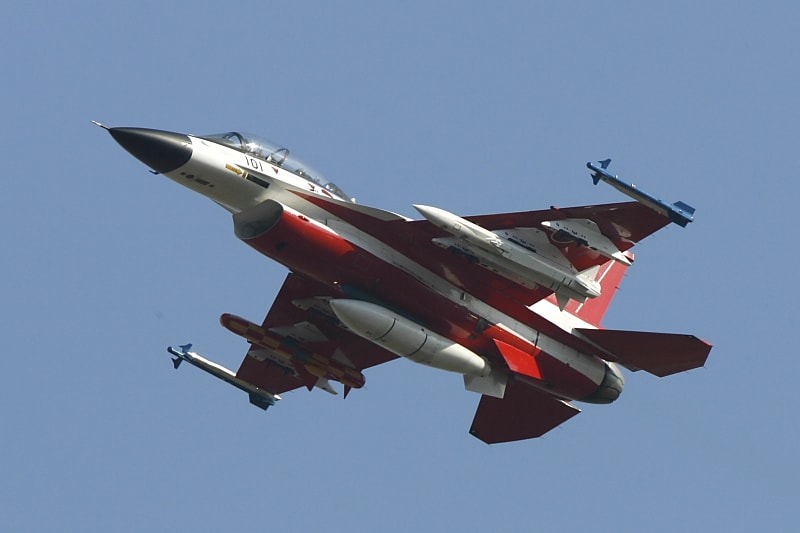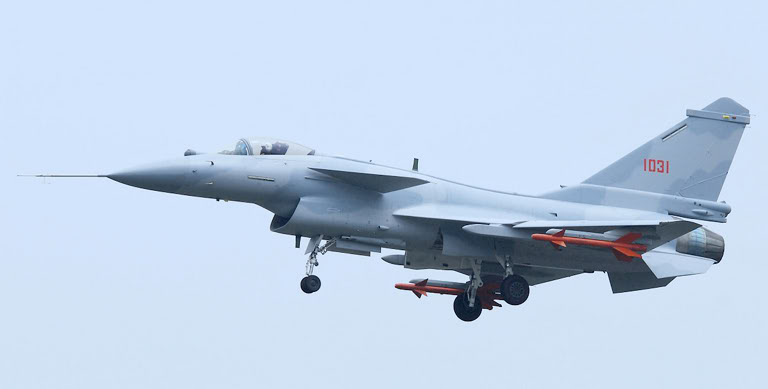
F-2
Posted on 10/14/2015 10:38:41 PM PDT by sukhoi-30mki
The rivalry between Japan and China over islands in the East China Sea has triggered close encounters between the two sides in the air. Chinese fighters have intercepted Japanese aircraft patrolling the Senkaku Islands (Diaoyu Islands to China), resulting in Japanese fighters being scrambled to intercept.
These aerial encounters in the Western Pacific highlight the People’s Liberation Army Air Force and the Japan Air Self Defense Force. China’s Su-27 and J-11 air superiority fighters are well known to outsiders, as are Japan’s equivalent, the F-15J Eagle.
Less well known are the single-engine multi-role fighters that back up their large, twin-engined cousins. China’s J-10 “Vigorous Dragon”, the first modern Chinese multi-role fighter, was introduced in 2005. An improved variant, the J-10B, has already entered service. Japan’s F-2 multi-role fighter entered service in 2000.
The Mistubishi F-2 fighter is the result of the FSX program, a joint Japanese-American project to develop a multi-role fighter. Both the F/A-18 Hornet and the F-16 Fighting Falcon were proposed as a baseline, with the F-16 eventually winning out. At the time, the FSX program was controversial as many in the U.S. Congress feared transferring advanced fighter technology to Japan.
Officially, the J-10 is the creation of the Chengdu Aircraft Design Group. Unofficially, it too has roots in an American aerospace program. The J-10 bears a striking resemblance to the joint American-Israeli Lavi fighter. Also based on the F-16, the Lavi was eventually canceled due to cost and political concerns. In 1987, the Office of Naval Intelligence stated that China had received Lavi—and thus American—technology, a conclusion shared with Jane’s.
A joint collaboration between Mitsubishi and Lockheed, the F-2 took the basic F-16 design and enlarged it. The aircraft includes a 25% larger wing area, GE F110 engine, and Japan’s J/APG-1, the world’s first active electronic scanning array radar installed on a fighter. It is armed with the Mitsubishi AAM-3 and AAM-5 infra-red guided air-to-air missiles (similar to the AIM-9 Sidewinder) and the AAM-4 radar-guided air-to-air missile (similar to the AIM-7 Sparrow.) The F-2 is also tasked with the anti-invasion mission, and is capable of carrying up to four ASM-2 anti-ship missiles. An M61 20-millimeter gatling gun rounds out the F-2’s armament.
Despite this, the aircraft is generally regarded as a failure. The per unit cost of the F-2 was a staggering $171 million dollars, more than four times that of an F-16C Block 50/52. Needless to say the F-2 was not four times as effective as the F-16. The lone upshot of the F-2 was the opportunity it gave Japan’s aerospace industry to work on a fighter program.
The J-10 fighter is a delta wing design, powered by Russian-made Saturn-Lyulka AL-31 afterburning turbofan engines. The aircraft is equipped with a Type 1473H pulse-doppler radar, and has 11 hard points for weapons and external fuel tanks. For air to air combat, the J-10 carries PL-9 infra-red guided air-to-air missiles and PL-12 radar guided missiles, and the Russian GSh-23 23-millimeter cannon. It can also carry a variety of laser and satellite-guided bombs.
All of that is very good, but which would win? At 520 miles, the F-2 has a better combat radius than the J-10, which is estimated at 340 miles. Assuming the two planes meet each other operating at equal distances from base, this would give the F-2 pilot slightly more fuel to maneuver and spend on speed. The J-10 also has an older design pulse-doppler radar to the F-2’s more modern AESA radar, so the F-2 would probably detect the J-10 first. The two planes are roughly the same weight, but the F-2 has a slightly better thrust to weight ratio.
All in all, the F-2 has the advantage.
The story doesn’t end there, though. Both countries are upgrading the J-10 and F-2. China has already started production of the J-10B. The B model features an improved engine, the AL-31FN, with improved thrust and range. Further improvements include a phased-array radar and infra-red search and track (IRST) for short-range air-to-air engagements.
In the case of Japan F-2 production has already ceased, so the emphasis is on upgrading existing planes. The F-2 is receiving new data links and a new radar, the J/APG-2, which will be mated with the AAM-4B air to air missile. The AAM-4B is currently the only missile in the world with its own AESA radar. The after-launch target lock capability of the AAM-4B allows pilots to launch the missile and begin evasive maneuvers before achieving radar lock.
Japan’s F-2 would have the advantage in long-range fights, being able to launch AAM-4B missiles from beyond visual range and then “turn and burn” in retreat. Thanks to their data links, F-2 units will be able to coordinate these long-range launches for maximum effect. Although China’s new phased array radar may be good, Japan’s long experience in radars means it’s safe to assume that the Japanese radar is better. J-10s might take serious losses in a scrape with the F-2 before they can even engage the enemy.
If on the other hand the J-10 could get in close, the infra-red search and track capability will give the Chinese fighter an advantage in short-range fights. The F-2 has no IRST.
Both the J-10 and F-2 have their advantages and disadvantages. At long ranges, the F-2 would eat the J-10 alive. At short ranges, the tables turn. The long-range battle comes first though, and the F-2’s advantage could be enough to end the fight before both sides enter visual range. In the end, the F-2 comes out ahead in this duel of fighters.

F-2
 J-10B
J-10B
That is a big honking missile under the port wing.
Wouldn’t even be close. F2 is a monster. And I might be wrong, but its engine is tuned for extreme performance at low altitude due to its mission.
That’s where the knife fights will happen.
Then you have to factor in Japanese pilot quality.
This is Lexus vs some Chinese built Buick.

So the Israelis repaid the favor of our sharing our fighter tech with them by selling it to China?
Sometimes engagements serve no greater purpose than to test new gear and deplete old inventory.
For your interest
Won’t the delta-canard configuration of the J-10 give it some traction? Should be interesting if pilots are equally matched.
Bill Clinton most likely had something to do with it.
Just curious- how do You know it has Active Radar Homing ?
The Chinese have documented it besting some of their J-11s and SU-27s.
It is a very decent aircraft and the Chinese have developed a significant training, and training regiment with their own aggressor squadrons and their own exercises like the "Red Flag" exercises like at Nellis Air Force Base.

I wouldn’t read too much into claims of a “wholly” Chinese design “besting” what are essentially Russian designs.
I would not discount it either.
The Chinese are doing some amazing things, and their own J-15, J-11B, J-16, etc. are as good as, if not better than the corresponding Russian aircraft.
Where they lack is engine technology. So they are not wholly “indigenous” when having to use Russian engines.
They have decent engines, but they do not measure up in power, efficiency, or maintainability to the Russian designs (which is why they still use them), Pratt & Whitney, Rolls Royce, etc.
What it will come down to is training, experience, and the sensors, ECM, and weapons.
I believe the Chinese are beginning to match in pure sensors. I believe their training is also catching up.
But they do not have the overall experience, the ECM is not as well known but I would rate it lower than the western designs and what Japan has, and I would rate the western/Japanese weapons as better, particularly in BVR, and in off-bore IR missiles.
But not a huge advantage in those last areas, because the Chinese are making rapid advances. It is something we and others cannot ignore, and where we cannot afford to sit on our laurels. The Japnese aren't.
Having said all of that, in a head to head matchup I would still give the match to the F-2...but a J-10B flown by an experienced pilot would be a very serious challenege and something that would have to be very respected.
I am looking very forward to the first flight of the new Japanese

Neither country has any recent experience in combat. It’s hard to guess what will happen. China’s military is primarily political in nature. It is designed for parades, not war.
How do I know? Being curios I checked it’s Wikipage. It’s probably correct. Actually it’s closer to AMRAAM AIM-120 in function.
“Guidance: inertial guidance, mid-course update + terminal active radar homing”
It gets its initial targeting info from the A/C and then pops on its radar for the close-in intercept.
The “B” version has a modern AESA radar system.
https://en.wikipedia.org/wiki/AAM-4
OK, Thank You, I confess I was lazy and “Brain dead” due to lack of coffee.
I was gonna say something along those lines about the engines as well...the GE engine is a pearl.
The article didn’t discuss the marked differences in the engine performance and quality.
Disclaimer: Opinions posted on Free Republic are those of the individual posters and do not necessarily represent the opinion of Free Republic or its management. All materials posted herein are protected by copyright law and the exemption for fair use of copyrighted works.